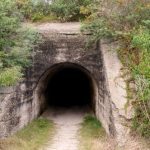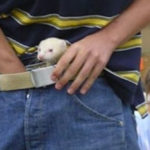 Mysteries
Mysteries  Mysteries
Mysteries  History
History 10 Surprising Stories About the Texas Rangers
 Humans
Humans 10 Philosophers Who Were Driven Mad by Their Own Theories
 Miscellaneous
Miscellaneous 10 Video-Game-Worthy Weapons and Armors from History
 Weird Stuff
Weird Stuff 10 Psychics Who Accurately Predicted Wartime Events
 The Arts
The Arts 10 Pieces of Art Inspired by a Broken Heart
 Health
Health 10 Science Fiction-Sounding New Medical Treatments
 History
History 10 Surprising Facts About the Father of Submarine Warfare
 Space
Space Ten Astonishing New Insights into Alien Worlds
 Weird Stuff
Weird Stuff 10 Bizarre Summer Solstice Rituals Still Practiced Today
 Mysteries
Mysteries Top 10 Haunting Facts About the Ghost Ship MV Alta
 History
History 10 Surprising Stories About the Texas Rangers
 Humans
Humans 10 Philosophers Who Were Driven Mad by Their Own Theories
Who's Behind Listverse?

Jamie Frater
Head Editor
Jamie founded Listverse due to an insatiable desire to share fascinating, obscure, and bizarre facts. He has been a guest speaker on numerous national radio and television stations and is a five time published author.
More About Us Miscellaneous
Miscellaneous 10 Video-Game-Worthy Weapons and Armors from History
 Weird Stuff
Weird Stuff 10 Psychics Who Accurately Predicted Wartime Events
 The Arts
The Arts 10 Pieces of Art Inspired by a Broken Heart
 Health
Health 10 Science Fiction-Sounding New Medical Treatments
 History
History 10 Surprising Facts About the Father of Submarine Warfare
 Space
Space Ten Astonishing New Insights into Alien Worlds
 Weird Stuff
Weird Stuff 10 Bizarre Summer Solstice Rituals Still Practiced Today
10 WWII Discoveries Kept Secret or Hidden for Decades
World War II (1939–1945) left behind many battlefields, death camps, and artifacts. Underneath this layer of well-known history lies a fascinating world of hidden things and places. Some were lost through time or kept secret on purpose, while others were buried by desperate hands. From a multi-billion dollar treasure diary to the horrifying Unit 731, here are some of the best-concealed discoveries that gave us a deeper insight into WWII.
Related: Top 10 Lesser-known Nazis Found Long After WWII Ended
10 This Map Caused a Ban
In 1944, while the Germans invaded the Dutch city of Arnhem, four of their soldiers robbed a bank. They stole precious stones, coins, and jewelry worth millions today. A year later, the same men were still in the Netherlands. Seeing the Allies closing in, they buried the loot in the village of Ommeren.
One soldier drew a map to help him retrieve the treasure at a later date. Somehow, this map ended up in the Dutch National Archives. It was only made public in 2023, but despite official searchers, no one could find the treasure. There are clues. The loot was buried in bread packages and ammunition boxes about 2 feet (0.6 m) deep. The location is described as “under the shade of a poplar tree.” But here’s the problem. The poplar tree is gone, and where it stood is anyone’s guess.
This didn’t stop unauthorized metal detectorists from buzzing the whole town. Eventually, Ommeren banned the practice. Not only because it annoyed the townsfolk, but there’s also the danger that someone might trigger buried WWII explosives.[1]
9 An Irish Message for Pilots
Not all countries jumped into the fray that was WWII. Ireland stayed neutral. However, still concerned that bombers might drop explosives on them, the Irish came up with a solution. In the summer of 1944, they gathered 150 tons (136 metric tons) of stones and used them to spell the word “EIRE” in large, whitewashed letters big enough for airborne pilots to read. Meaning “Ireland” in the Irish language, the signs reminded bombers that they were flying over neutral territory.
In 2018, wildfires swept through County Wicklow. The blaze cleared enough brush to reveal a previously unknown “EIRE” at Bray. Ironically, it was first spotted by a police helicopter flying over the area after the fire. Above the sign was a faint number 8. This would’ve been the number of a now-gone lookout post. Every sign, and there are about 83 of them along the Irish coast, came with a post that was manned 24 hours a day to guard against German invasion. [2]
8 A Rare German Wall Stash
In 2021, severe flooding damaged a woman’s house in Hagen, Germany. When a family member cleaned the place and removed rotten plasterboard, he was surprised to find a secret hiding space in the wall. It was packed with documents, a revolver, gas masks, brass knuckles, letters, Nazi Party badges, a portrait of Adolf Hitler, and a newspaper dated 1945.
As it turns out, the cache was a rare discovery. Near the end of the war, many Germans quickly hid sensitive materials when Allied troops marched into their cities. Still, it’s quite unusual to find an untouched trove such as this one.
Once researchers looked into the case, they discovered that during WWII, the house was the local headquarters of an organization called the National Socialist People’s Welfare (NSV). Known for running kindergartens and relief operations, the 12 boxes of materials might now throw some light on the charity’s role in the Nazi regime.[3]
7 Lost Tale of a Count’s Death

In 2017, a teenager was at Lake Zeziorak in Poland when he unearthed old milk cans. The cans contained personal items, valuables, documents, and a German officer’s uniform. The authorities identified the owner as an aristocratic Prussian called Count Hans Joachim von Finckenstein.
During the war, his family lived by the lake when the area was a German province. Some of what happened to them fell into place when researchers tracked down the count’s daughter, Waldtraut, now aged 81. She explained that she and her sister were sent away before the Russians invaded the region, but their parents stayed behind. The count was arrested by Soviet soldiers in 1945 and later died in a prisoner camp. His wife was thought to have buried the family heirlooms before she was later reunited with her children in Germany.
Interestingly, one note in the cache suggests that things didn’t immediately go south for the count and his wife. Written by a Soviet officer, it said, “Comrades and soldiers, please do not harm the inhabitants of this house. They welcomed us.” It’s unknown why this request wasn’t enough to stop the count’s arrest.[4]
6 Bunker for Churchill’s “Secret Army”
Winston Churchill had a secret army of auxiliary units. As Britain’s last line of defense against a German invasion, these elite fighters were chosen for their knowledge of local areas and trained to sabotage and assassinate the enemy. Launching surprise attacks was part of the plan, so roughly 500 bunkers were built where they would lie in wait for German soldiers. Luckily for both sides, Great Britain was never invaded during WWII.
Today, it’s extremely rare to find these bunkers. The builders signed the Official Secrets Act, which prevented them from mentioning their work. With no one talking about it, most of the bunkers’ locations were lost to history.
In 2020, researchers from Forestry and Land Scotland were tasked with looking for historical sites before a tree-felling project. Incredibly, one team member remembered finding one of these bunkers when he played in the forest over 40 years ago. Relying only on his memory, they located the underground hideaway, which measured about 23 feet (7 meters) long and 10 feet (3 meters) wide. For now, due to its historical value, its location will remain a secret.[5]
5 An Enigma Machine
The Allies faced a dangerous enemy device—a typewriter. But not just any typewriter. The Germans used the so-called Enigma machine to send coded messages that were impossible to crack. The story of how Polish and British codebreakers solved the cipher and shortened the war by several years became one of the most enduring legends of WWII.
Today, Enigma machines are incredibly rare. In 2020, a dive team wasn’t even thinking about such an artifact when they donned their flippers and dove into the Baltic Sea. Their mission was environmental; remove abandoned fishing nets from the Bay of Gelting near Germany. One diver found a net, and it was wrapped around a rusty-looking typewriter. They soon realized that this “junk” was a legendary Enigma machine.
The device was most likely tossed overboard from a German warship near the end of the war. After decades of being submerged in seawater, the machine began a year-long restoration process before going on display in a museum.[6]
4 A Village Secret
It’s rare for a whole village to keep a secret from outsiders. However, during WWII, the Cornish community of St. Erth did just that. They told no one that their village hid an M16 outstation, mainly because it eavesdropped on German radio communications. The station had about 100 members, and one of them, Harry Griffiths, left his codebook to his son, Mike, after he passed away.
Mike eventually wrote a book about the important role the station played in the war. Perfectly located, it had unrestricted radio waves that tracked U-boats far into the Atlantic. The radiomen captured information from the Germans, which was then sent to the codebreakers at Bletchley Park (of Enigma fame). Additionally, the station also helped to gather such a complete picture of the German war machine that German officers being interrogated after the war was stunned by how much the British already knew.
Today, the only traces of the St. Erth listening station is an old guard hut and a derelict gate.[7]
3 The Michaelis Diary
Most diaries are boring—but not this one. It appears to point toward billions of dollars worth of treasure. According to the book’s backstory, it was penned by an SS officer who used “Michaelis” as a pseudonym. He wrote about Nazi commander Heinrich Himmler’s plans to squirrel away all the wealth that Germany had stolen in Europe.
The book was concealed for decades by a Masonic lodge in the town of Quedlinburg, Germany. Why? “Michaelis” was said to be a member of this lodge, and for a long time, the secret society also included the descendants of elite Nazi officials. But in 2019, the diary came to light when the lodge gifted the book to the Polish as an apology for WWII.
While it’s true that the book was written during the war, it’s unknown if the whole treasure story is authentic. The author listed 11 sites where priceless loot is buried, and one location might reveal the truth. There’s supposedly an abandoned well under the 16th-century Hochberg Palace in Poland that holds over 30 tons (28 metric tons) of gold. The owners plan to restore the building, and the upcoming conservation work will include a hunt for the well.[8]
2 The YIVO Library
During WWII, up to 95% of Lithuanian Jews were slaughtered by the Germans. Not even their religious culture was spared. And what a rich culture it was. In particular, the city of Vilna was called the “Jerusalem of Lithuania,” where the Yiddish Scientific Institute (YIVO) had amassed a vast collection of Jewish history, Yiddish language studies, literature, and folklore.
When the Germans captured the YIVO headquarters in Vilna, 40 Jewish scholars were ordered to destroy 70% of their library and choose a small selection of documents their captors would then take to a future Frankfurt museum. Despite being supervised by Nazis, the daring men strapped documents to their chests and hid them away in the city’s ghetto, where all Jews were forced to live.
Over the years, some of the hidden documents resurfaced. Between 1989 and 1991, about 250,000 pages were removed from the basement of a church in Vilna. A second trove of 170,000 pages was found in another room in 2016. Some modern scholars view the materials as the most important Jewish archives discovered since the Dead Sea Scrolls.[9]
1 Unit 731
Unit 731 holds a special place of dishonor in the history books. Run by the Japanese army, the unit killed up to 12,000 men, women, and children by performing live “autopsies” without anesthesia and exposing them to deadly biological and chemical weapons and other truly terrifying experiments. The unit also wiped out hundreds of thousands more by breeding plague-infected fleas and air-dropping them on Chinese cities.
Despite its infamy, the location of this bunker was lost. Records only showed that it was built in China in 1941 when the Japanese occupied the country and that it shut down near the end of WWII. But recently, Chinese archaeologists unearthed an underground structure near the city of Anda, and they are convinced that it’s the notorious Unit 731.
The bunker’s design supports this theory. Unit 731 was Imperial Japan’s biggest test site, and the newly discovered site consists of a complex maze of rooms and tunnels, measuring roughly 108 feet (33 meters) long and 67 feet (21 meters) wide. Some of the rooms also appear to be laboratories, holding cells, dissection rooms, viewing rooms, and barracks.[10]








